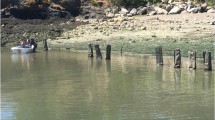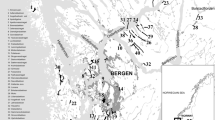Abstract
High densities of habitat modifiers can dramatically alter the structure of ecosystems. Whereas spawning sockeye salmon (Oncorhynchus nerka) dig nests that cover over 2 m2 and are at least 20 cm deep, and can spawn at high densities, relatively little attention has been devoted to investigating the impacts of this disturbance. We hypothesized that this temporally and spatially predictable bioturbation has large impacts on the coastal aquatic habitats used by sockeye. We experimentally investigated the impacts of disturbance caused by spawning sockeye in two streams and two lakes in Alaska by excluding salmon from 2.25 m2 plots where they traditionally spawn. We sampled exclusions and control plots before, during, and after spawning. During sockeye spawning, fine sediment accumulated in areas where sockeye were excluded from spawning. In addition, sockeye spawning significantly decreased algal biomass by 80% compared to exclusion plots. We found mixed effects of spawning on the invertebrate assemblage. Tricladida and Chironomidae densities increased by 3x in exclusion plots relative to control plots in one creek site. However, for most taxa and sites, invertebrate densities declined substantially as spawning progressed, regardless of experimental treatment. Habitat modification by spawning salmon alters both community organization and ecosystem processes.




Similar content being viewed by others
References
Bayley PB (1995) Understanding large river-floodplain ecosystems. BioScience 45:153–158
Bilby RE, Fransen BR, Bisson PA, Walter JK (1998) Response of juvenile coho salmon (Oncorhynchus kisutch) and steelhead (Oncorhynchus mykiss) to the addition of salmon carcasses to two streams in southwestern Washington, USA. Can J Fish Aquat Sci 55:1909–1918
Brenchley GA (1981) Disturbance and community structure: an experimental study of bioturbation in marine soft-bottom environments. J Mar Res 39:767–790
Carpenter S, McCreary NJ (1985) Effects of fish nests on pattern and zonation of submersed macrophytes in a softwater lake. Aquat Bot 22:21–32
Clarke KR (1993) Non-parametric multivariate analyses of changes in community structure. Aust J Ecol 18:117–143
Clarke KR, Warwick RM (1994) Change in marine communities: an approach to statistical analysis and interpretation. PRIMER-E, Plymouth, UK
Coleman FC, Williams SL (2002) Overexploiting marine ecosystem engineers: potential consequences for biodiversity. Trends Ecol Evol 17:40–44
Crowl TA (2001) Freshwater shrimp effects on detrital processing and nutrients in a tropical headwater stream. Ecology 82:775–783
Edmunds GFJ, Jensen SL, Berner L (1976) The mayflies of North and Central America. University of Minnesota Press, Minneapolis, USA
Ende CN von (1993) Repeated-measures analysis: growth and other time-dependent measures. In: Scheiner SM, Gurevitch J (eds) Design and analysis of ecological experiments. Chapman and Hall, New York, pp 113–137
Fausch KD, Taniguchi Y, Nakano S, Grossman GD, Townsend CR (2001) Flood disturbance regimes influence rainbow trout invasion success among five holarctic regions. Ecol Appl 11:1438–1455
Field-Dodgson MS (1987) The effect of salmon redd excavation on stream substrate and benthic community of two salmon spawning streams in Canterbury, New Zealand. Hydrobiologia 154:3–11
Finlay JC, Khandwala S, Power ME (2002) Spatial scales of carbon flow in a river food web. Ecology 83:1845–1859
Flecker AS (1996) Ecosystem engineering by a dominant detritivore in a diverse tropical stream. Ecology 77:1845–1854
Flecker AS, Taylor BW, Bernhardt ES, Hood JM, Cornwell WK, Cassatt SR, Vanni MJ, Altman NS (2002) Interactions between herbivorous fishes and limiting nutrients in a tropical stream ecosystem. Ecology 83:1831–1844
Gende SM, Edwards RT, Willson MF, Wipfli MS (2002) Pacific salmon in aquatic and terrestrial ecosystems. BioScience 52:917–928
Gray LJ, Fisher SG (1981) Postflood recolonization pathways of macroinvertebrates in a lowland sonoran desert stream. Am Midl Nat 106:249–257
Groot C, Margolis L (eds) (1991) Pacific salmon life histories. University of British Columbia Press, Vancouver, Canada
Hildebrand SG (1971) The effect of coho spawning on the benthic invertebrates of the Platte River, Benzie County, Michigan. Trans Am Fish Soc 100:61–68
Iwasa Y, Levin SA (1995) The timing of life history events. J Theor Biol 172:33–42
Jones CG, Lawton JH, Shachak M (1994) Organisms as ecosystem engineers. Oikos 69:373–386
Jones CG, Lawton JH, Shachak M (1997) Positive and negative effects of organisms as physical ecosystem engineers. Ecology 78:1946–1957
Kline TCJ, Goering JJ, Mathisen OA, Poe PH, Parker PL (1990) Recycling of elements transported upstream by runs of Pacific salmon: I. 15N and 13C evidence in Sashin Creek, Southeastern Alaska. Can J Fish Aquat Sci 47:136–144
Kondolf GM, Sale MJ, Wolman MG (1993) Modification of fluvial gravel size by spawning salmonids. Water Resour Res 29:2265–2274
Kupriyanova EK, Bailey CF (1998) The disturbance effect of largemouth bass nesting on a benthic macroinvertebrate community. J Freshwater Ecol 13:333–341
Lawton JH, Jones CG (1995) Linking species and ecosystems: organisms as ecosystem engineers. In: Jones CG, Lawton JH (eds) Linking species and ecosystems. Chapman and Hall, New York, pp 141–150
Lichatowich J (1999) Salmon without rivers. Island Press, Washington, D.C.
Loveless CM (1959) A study of the vegetation in the Florida Everglades. Ecology 40:1–9
Lytle DA (1999) Use of rainfall cues by Abedus herberti (Hemiptera: Belostomatidae): a mechanism for avoiding flash floods. J Insect Behav 12:1–12
Lytle DA (2000) Biotic and abiotic effects of flash flooding in a montane desert stream. Arch Hydrobiol 150:85–100
Lytle DA (2001) Disturbance regimes and life-history evolution. Am Nat 157:525–536
Lytle DA (2002) Flash floods and aquatic insect life-history evolution: evaluation of multiple models. Ecology 83:370–385
March JG, Pringle CM, Townsend MJ, Wilson AI (2002) Effects of freshwater shrimp assemblages on benthic communities along an altitudinal gradient of a tropical island stream. Freshwater Biol 47:377–390
Marker AFH, Crowther CA, Gunn RJM (1980) Methanol and acetone as solvents for estimation of chlorophyll a and phaeopigments by spectrophotometry. Arch Hydrobiol 14:52–69
Marriott RA (1964) Stream catalog of the Wood River lake system, Bristol Bay, Alaska. United States Fish and Wildlife Service, Washington, D.C.
McCune B, Grace JB (2002) Analysis of ecological communities. MjM Software Design, Gleneden Beach, Ore.
Merritt RW, Cummins KW (eds) (1978) An introduction to the aquatic insects of North America. Kendall/Hunt Publishing Company, Dubuque, Iowa
Minakawa N, Gara RI (1999) Ecological effects of a chum salmon (Oncorhynchus keta) spawning run in a small stream of the Pacific Northwest. J Freshwater Ecol 14:327–335
Minakawa N, Gara RI (2003) Effects of chum salmon redd excavation on benthic communities in a stream in the Pacific Northwest. Trans Am Fish Soc 132:598–604
Montgomery DR, Buffington JM, Peterson NP, Schuett-Hames D, Quinn TP (1996) Stream-bed scour, egg burial depths, and the influence of salmonid spawning on bed surface mobility and embryo survival. Can J Fish Aquat Sci 53:1061–1070
Myers AC (1977) Sediment processing in a marine subtidal sandy bottom community: I. Physical aspects. J Mar Res 35:609–632
Naiman RJ, Melillo JM, Hobbie JE (1986) Ecosystem alteration of boreal forest streams by beaver (Castor canadensis). Ecology 67:1254–1269
Naiman RJ, Bilby RE, Schindler DE, Helfield JM (2002) Pacific salmon, nutrients, and the dynamics of freshwater and riparian ecosystems. Ecosystems 5:399–417
National Research Council (NRC) (1996) Upstream: salmon and society in the Pacific Northwest. National Academy Press, Washington, D.C.
Paine RT (1992) Food-web analysis through field measurement of per capita interaction strength. Nature 355:73–75
Peckarsky BL, Penton MA (1990) Effects of enclosures on stream microhabitat and invertebrate community structure. J N Am Benthol Soc 9:249–261
Peterson CH (1979) Predation, competitive exclusion, and diversity in the soft-sediment benthic communities of estuaries and lagoons. In: Livingston RJ (ed) Ecological processes in coastal and marine systems. Plenum, New York, pp 233–264
Peterson DP, Foote CJ (2000) Disturbance of small-stream habitat by spawning sockeye salmon in Alaska. Trans Am Fish Soc 129:924–934
Polis GA, Anderson WB, Holt RD (1997) Toward an integration of landscape and food web ecology: the dynamics of spatially subsidized food webs. Annu Rev Ecol Syst 28:289–316
Power ME (1990) Resource enhancement by indirect effects of grazers: armored catfish, algae, and sediments. Ecology 71:897–904
Power ME (1997) Estimating impacts of a dominant detritivore in a neotropical stream. Trends Ecol Evol 12:47–49
Power ME, Parker MS, Wootton JT (1996) Disturbance and food chain length in rivers. In: Polis GA, Winemiller KO (eds) Food webs: integration of patterns and dynamics. Chapman and Hall, New York, pp 286–297
Pringle CM, Blake GA (1994) Quantitative effects of Atyid shrimp (Decapoda: Atyidae) on the depositional environment in a tropical stream: use of electricity for experimental exclusion. Can J Fish Aquat Sci 51:1443–1450
Resh VH, Brown AV, Covich AP, Gurtz ME, Li HW, Wayne GW, Reice SR, Sheldon AL, Wallace JB, Wissmar RC (1988) The role of disturbance in stream ecology. J N Am Benthol Soc 7:433–455
Scheffer M, Carpenter S, Foley JA, Foke C, Walker B (2001) Catastrophic shifts in ecosystems. Nature 413:591–596
Schindler DE, Scheuerell MD, Moore JW, Gende SM, Francis TB, Palen WJ (2003) Pacific salmon and the ecology of coastal ecosystems. Front Ecol Environ 1:31–37
Schuldt JA, Hershey AE (1995) Effect of salmon carcass decomposition on Lake Superior tributary streams. J N Am Benthol Soc 14:259–268
Snodgrass JW, Meffe GK (1998) Influence of beavers on stream fish assemblages: effects of pond age and watershed position. Ecology 79:928–942
Statzner B, Fuchs U, Higler LWG (1996) Sand erosion by mobile predaceous stream insects: implications for ecology and hydrology. Water Resour Res 32:2279–2287
Statzner B, Arens MF, Champagne JY, Morel R, Herouin E (1999) Silk-producing stream insects and gravel erosion: significant biological effects on critical shear stress. Water Resour Res 35:3495–3506
Statzner B, Fievet E, Champagne JY, Morel R, Herouin E (2000) Crayfish as geomorphic agents and ecosystem engineers: Biological behavior affects sand and gravel erosion in experimental streams. Limnol Oceanogr 45:1030–1040
Steen RP, Quinn TP (1999) Egg burial depth by sockeye salmon (Oncorhynchus nerka): implications for survival of embryos and natural selection on female body size. Can J Zool 77:836–841
Stewart KW, Stark BP (1993) Nymphs of North American stonefly genera (Plecoptera). University of North Texas Press, Denton, Texas
Thompson RM, Townsend CR (2003) Impacts of stream food webs of native and exotic forest: an intercontinental comparison. Ecology 84:145–161
Thorp JH (1988) Patches and the responses of lake benthos to sunfish nest-building. Oecologia 76:168–174
Thorp JH, Covich AP (eds) (1991) Ecology and classification of North American freshwater invertebrates. Academic Press, San Diego
Thorp JH, Goldsmith LD, Polgreen JA, Mayer LM (1989) Foraging patterns of nesting and nonnesting sunfish (Centrarchidae: Lepomis auritus and L. gibbosus). Can J Fish Aquat Sci 46:1342–1346
Wiggins GB (1977) Larvae of the North American caddisfly genera (Tricoptera). University of Toronto Press, Toronto
Willson MF, Halupka KC (1995) Anadromous fish as keystone species in vertebrate communities. Conserv Biol 9:489–497
Wipfli MS, Hudson JP, Chaloner DT, Caouette JP (1999) Influence of salmon spawner densities on stream productivity in Southeast Alaska. Can J Fish Aquat Sci 56:1600–1611
Wootton JT, Parker MS, Power ME (1996) Effects of disturbance on river food webs. Science 273:1558–1561
Zar JH (1999) Biostatistical analysis. Prentice Hall, New Jersey
Acknowledgements
This is a contribution from the Alaska Salmon Program at the University of Washington. This work was supported in part by grants from the National Science Foundation, funding from the Bristol Bay salmon processors, as well as fellowships to J.W. Moore from the ARCS foundation, the National Science Foundation, and the department of Zoology at the University of Washington. Jenn Anson, Chris Boatright, Anne Carlson, Brandon Chasco, Tessa Francis, Karen Knirsken, Wendy Palen, and Laura Payne provided critical field or laboratory assistance. Eric Buhle, Stephanie Hampton, Jennifer Ruesink, Amanda Stanley, and two anonymous reviewers provided helpful feedback on earlier drafts of this manuscript.
Author information
Authors and Affiliations
Corresponding author
Rights and permissions
About this article
Cite this article
Moore, J.W., Schindler, D.E. & Scheuerell, M.D. Disturbance of freshwater habitats by anadromous salmon in Alaska. Oecologia 139, 298–308 (2004). https://doi.org/10.1007/s00442-004-1509-3
Received:
Accepted:
Published:
Issue Date:
DOI: https://doi.org/10.1007/s00442-004-1509-3




